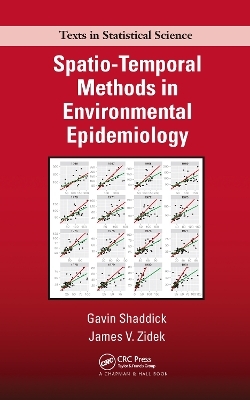
Spatio-Temporal Methods in Environmental Epidemiology
Chapman & Hall/CRC (Verlag)
978-0-367-78346-4 (ISBN)
Spatio-Temporal Methods in Environmental Epidemiology with R, like its first Edition, explores the interface between environmental epidemiology and spatio-temporal modelling. It links recent developments in spatio-temporal theory with epidemiological applications. Drawing on real-life problems, it shows how recent advances in methodology, can assess the health risks associated with environmental hazards. The book's clear guidelines enable the implementation of the methodology and estimation of risks in practice. New additions to the second edition include : a thorough exploration of the underlying concepts behind knowledge discovery through data; a new chapter on extracting information from data using R and the Tidyverse; additional material on methods for Bayesian computation, including the use of NIMBLE and Stan; new methods for performing spatio-temporal analysis and an updated chapter containing further topics. Throughout the book there are new examples and the presentation of R code for examples has been extended. Along with these additions, the book now has a GitHub site (https://spacetime-environ.github.io/stepi2) that contains data, code and further worked examples.
Features
• Explores the interface between environmental epidemiology and spatio temporal modelling;
• Incorporates examples that show how spatio-temporal methodology can inform societal concerns about the effects of environmental hazards on health;
• Uses a Bayesian foundation on which to build an integrated approach to spatio-temporal modelling and environmental epidemiology;
• Discusses data analysis and topics such as data visualization, mapping, wrangling and analysis
• Shows how to design networks for monitoring hazardous environmental processes networks and the ill-effects of preferential sampling;
• Through the listing and application of code, shows the power of R, tidyverse, NIMBLE and Stan and other modern tools in performing complex data analysis and modelling.
Representing a continuing important direction in environmental epidemiology, this book -- in full color throughout -- underscores the increasing need to consider dependencies in both space and time when modelling epidemiological data. Readers will learn how to identify and model patterns in spatio-temporal data and how to
exploit dependencies over space and time to reduce bias and inefficiency when estimating risks to health.
Gavin Shaddick is a reader in statistics in the Department of Mathematical Sciences at the University of Bath. He received his master’s in applied stochastic systems from University College London and his PhD in statistics and epidemiology from Imperial College London. His research interests include the theory and application of Bayesian statistics to the areas of spatial epidemiology, environmental health risk, and the modeling of spatio-temporal fields of environmental hazards. Of particular interest are computational techniques that allow the implementation of complex statistical models to real-life applications where the scope over both space and time may be very large. Dr. Shaddick is actively involved in a number of substantive epidemiological projects related to the effects of air pollution to health. He has worked on many large-scale funded projects, including the high-resolution mapping of environmental pollutants, the utilization of information from multiple sources in estimating exposures to environmental hazards, and the characterization of uncertainty in scenario assessment and policy support. He is a co-author of the Oxford Handbook of Epidemiology for Clinicians, which was Highly Commended in the Basis of Medicine Category, BMA Book Awards 2013. James V. Zidek is a professor emeritus in the Department of Statistics at the University of British Columbia. Professor Zidek received his MSc and PhD in statistics from the University of Alberta and Stanford University, respectively. He began his research career working on Wald’s statistical decision theory. That interest shifted into Bayesian decision analysis. His interest in applications also emerged early in his career and as a consultant, published with engineering collaborators, the first design code for long-span bridges, such as the famous Golden Gate Bridge in San Francisco. The combination of theory and practice led him to an EPA project on acid rain where he, with a few of his collaborators, started to lay the foundations of environmetrics as it is now called, notably on the design of environmental monitoring networks and spatio-temporal modeling of environmental processes. That work led naturally into spatio-temporal epidemiology, which remains an area of interest. He has published about 100 refereed articles and a book on modeling environmental processes. His contributions to statistics have been recognized by a number of honors. He is a fellow of the ASA, IMS, and Royal Society of Canada; member of the ISI; and a recipient of the Gold Medal of the Statistical Society of Canada (its highest honor).
Why spatio-temporal epidemiology? Modelling health risks. The importance of uncertainty. Embracing uncertainty: the Bayesian approach. The Bayesian approach in practice. Strategies for modeling. Is ‘real’ data always quite so real? Spatial patterns in disease. From points to fields: modelling environmental hazards over space. Why time also matters. The interplay between space and time in exposure assessment. Roadblocks on the way to causality: exposure pathways, aggregation and other sources of bias. Better exposure measurements through better design. New frontiers. Appendices. References. Indices.
| Erscheinungsdatum | 06.04.2021 |
|---|---|
| Reihe/Serie | Chapman & Hall/CRC Texts in Statistical Science |
| Sprache | englisch |
| Maße | 156 x 234 mm |
| Gewicht | 739 g |
| Themenwelt | Mathematik / Informatik ► Mathematik |
| Studium ► Querschnittsbereiche ► Epidemiologie / Med. Biometrie | |
| Naturwissenschaften ► Biologie | |
| Naturwissenschaften ► Geowissenschaften ► Geologie | |
| ISBN-10 | 0-367-78346-0 / 0367783460 |
| ISBN-13 | 978-0-367-78346-4 / 9780367783464 |
| Zustand | Neuware |
| Informationen gemäß Produktsicherheitsverordnung (GPSR) | |
| Haben Sie eine Frage zum Produkt? |
aus dem Bereich


